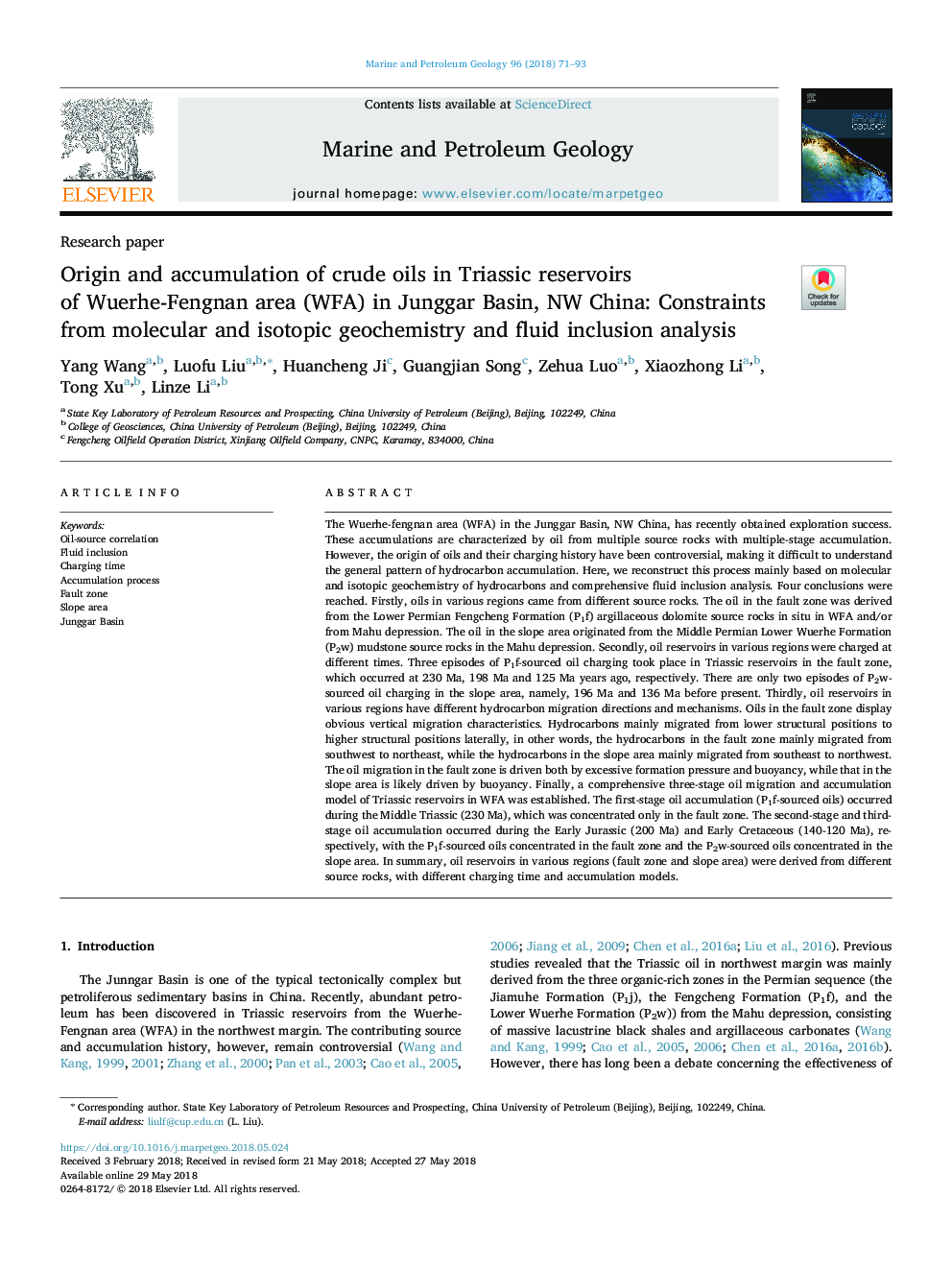| کد مقاله | کد نشریه | سال انتشار | مقاله انگلیسی | نسخه تمام متن |
|---|---|---|---|---|
| 8908964 | 1637129 | 2018 | 23 صفحه PDF | دانلود رایگان |
عنوان انگلیسی مقاله ISI
Origin and accumulation of crude oils in Triassic reservoirs of Wuerhe-Fengnan area (WFA) in Junggar Basin, NW China: Constraints from molecular and isotopic geochemistry and fluid inclusion analysis
دانلود مقاله + سفارش ترجمه
دانلود مقاله ISI انگلیسی
رایگان برای ایرانیان
کلمات کلیدی
موضوعات مرتبط
مهندسی و علوم پایه
علوم زمین و سیارات
زمین شناسی اقتصادی
پیش نمایش صفحه اول مقاله

چکیده انگلیسی
The Wuerhe-fengnan area (WFA) in the Junggar Basin, NW China, has recently obtained exploration success. These accumulations are characterized by oil from multiple source rocks with multiple-stage accumulation. However, the origin of oils and their charging history have been controversial, making it difficult to understand the general pattern of hydrocarbon accumulation. Here, we reconstruct this process mainly based on molecular and isotopic geochemistry of hydrocarbons and comprehensive fluid inclusion analysis. Four conclusions were reached. Firstly, oils in various regions came from different source rocks. The oil in the fault zone was derived from the Lower Permian Fengcheng Formation (P1f) argillaceous dolomite source rocks in situ in WFA and/or from Mahu depression. The oil in the slope area originated from the Middle Permian Lower Wuerhe Formation (P2w) mudstone source rocks in the Mahu depression. Secondly, oil reservoirs in various regions were charged at different times. Three episodes of P1f-sourced oil charging took place in Triassic reservoirs in the fault zone, which occurred at 230 Ma, 198 Ma and 125 Ma years ago, respectively. There are only two episodes of P2w-sourced oil charging in the slope area, namely, 196 Ma and 136 Ma before present. Thirdly, oil reservoirs in various regions have different hydrocarbon migration directions and mechanisms. Oils in the fault zone display obvious vertical migration characteristics. Hydrocarbons mainly migrated from lower structural positions to higher structural positions laterally, in other words, the hydrocarbons in the fault zone mainly migrated from southwest to northeast, while the hydrocarbons in the slope area mainly migrated from southeast to northwest. The oil migration in the fault zone is driven both by excessive formation pressure and buoyancy, while that in the slope area is likely driven by buoyancy. Finally, a comprehensive three-stage oil migration and accumulation model of Triassic reservoirs in WFA was established. The first-stage oil accumulation (P1f-sourced oils) occurred during the Middle Triassic (230 Ma), which was concentrated only in the fault zone. The second-stage and third-stage oil accumulation occurred during the Early Jurassic (200 Ma) and Early Cretaceous (140-120 Ma), respectively, with the P1f-sourced oils concentrated in the fault zone and the P2w-sourced oils concentrated in the slope area. In summary, oil reservoirs in various regions (fault zone and slope area) were derived from different source rocks, with different charging time and accumulation models.
ناشر
Database: Elsevier - ScienceDirect (ساینس دایرکت)
Journal: Marine and Petroleum Geology - Volume 96, September 2018, Pages 71-93
Journal: Marine and Petroleum Geology - Volume 96, September 2018, Pages 71-93
نویسندگان
Yang Wang, Luofu Liu, Huancheng Ji, Guangjian Song, Zehua Luo, Xiaozhong Li, Tong Xu, Linze Li,